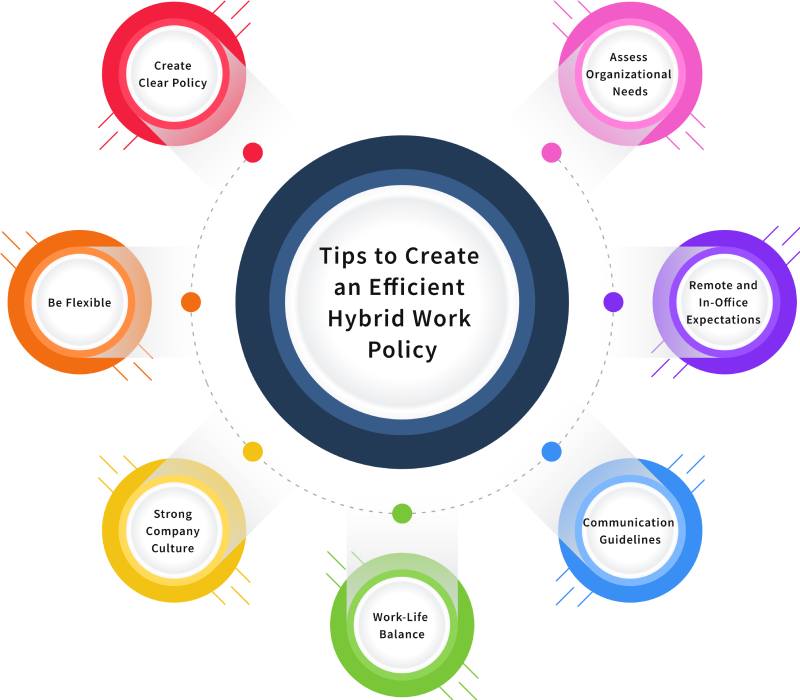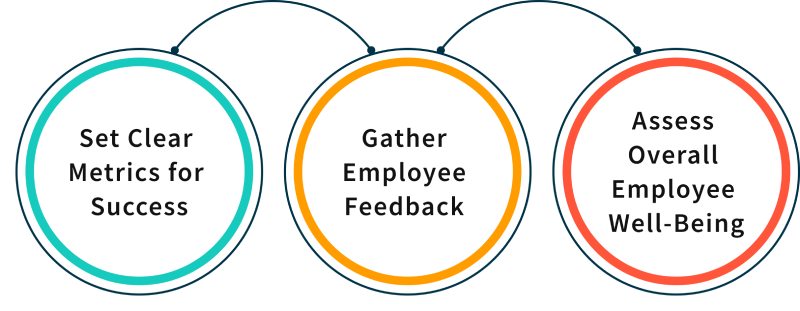When your employees work from home some days and from the office on others. It’s important to create an effective hybrid work policy to avoid confusion and keep your employees happy and productive. In this blog, we will share the top 7 tips to create a hybrid work policy that meets your business goals and keeps your team engaged and motivated. Let’s dive in!
What is a Hybrid Work Policy?
A hybrid work policy helps you create a flexible work environment for both in-office and remote employees. It gives your team a clear structure, so everyone knows what to expect, no matter where they are working. According to the Office for National Statistics survey, 78% of individuals reported improved their work-life balance due to flexible work arrangements. It shows how important it is to make a work policy that mixes in-office and remote work to satisfy your employees and get more work done.
How Hybrid Work Policies Benefit Your Organization?
Let’s take a look at some of the benefits of hybrid work policies:
1. Clear Structure
The hybrid working policy is like having a map for your team to follow and navigate through the new working model. It informs everyone when they should work from home or come to the office. When everyone knows what to expect, confusion drops and productivity often goes up.
According to McKinsey reports, companies with well-defined policies have happier and more satisfied employees. Furthermore, if everyone in your team is aware of the guidelines, they can focus on getting things done instead of stressing about where they should be.
2. Fairness and Transparency
When your employees know the rules, it makes the environment fair. Everyone should have access to information about expectations and opportunities. According to the Society for Human Resource Management (SHRM) research, organizations that are transparent and communicate effectively with their employees have higher employee engagement.
When fairness is present in your company, your employees are more likely to stay loyal to your organization, improving employee retention and encouraging them to work even harder. It has a very positive impact on the morale of your team, leading to higher productivity.
3. Good Communication
Flexible work arrangements enable you to establish open discussions among your employees. Then all employees are kept informed and connected irrespective of their place of work. A study by Buffer shows that 20% of remote employees experienced loneliness.
These lonely feelings can however be overcome through good communication. This results in a better working climate. Creating a good communication culture is one of the crucial success factors in a hybrid work model.
4. Employee Accountability
When your employees understand what is expected of them, they can own their tasks. This feeling of responsibility promotes higher performance and increases job satisfaction. A Gallup report also reveals that engaged employees are likely to perform beyond the expectations of their contract with the organization.
By empowering accountability, you empower your team to succeed. This approach not only improves individual performance but also creates better results for the whole organization.
5. Scalability and Adaptability
As your business grows or faces new challenges, these policies can be adjusted to meet different needs. Flexibility is important in today’s fast-changing work environment. A report from Deloitte shows that organizations with adaptable work policies are better equipped to handle difficulties.
This adaptability supports growth and helps keep top talent. When your workplace is flexible, it shows that you value your team and their circumstances. This approach not only benefits your organization but also creates a happier and more engaged workforce.
Components You Need to Include in Hybrid Work Policy
To create an effective hybrid work policy, you must get the right things to create clarity, accountability, and alignment with your business goals. A well-structured policy helps you set expectations and makes it easier for you to lead hybrid teams smoothly. Here’s what you need to include:
1. Work Schedule and Availability
Define work hours and availability of employees clearly. Let your employees know when they should stick to set hours and when they are free to choose whatever they want. When your team is distributed across different time zones, decide that everyone should be on together at particular hours to facilitate communication. Don’t forget to clarify the way employees should request half days, schedule changes, or time off to avoid confusion.
Make it a rule to encourage your employees to use shared calendars and everyone can see when their teammates are available. Then it’s easier to set up meetings and figure out who will be in the office. Quiet hours, or no meeting times, can help prevent employee burnout and provide time for employees to work.
2. Communication Protocols
Your policy should say which tools to use for different types of communication. For example, use chat tools like Slack for quick messages, email for important notes, and video calls like Zoom for meetings. This helps everyone know where to go for different needs. And let your employees set specific response times to keep the work running without any kind of interruption.
Set up meeting rules such as when you are not talking, employees should mute their mic, actively participate in the discussions, and turn their cameras on when needed. You should offer a protocol for project updates if all participants are not online at the same time. If something needs immediate attention, then make sure you provide an emergency communication system.
3. Performance and Productivity Tracking
Tell employees how you will monitor their performance and productivity in office and remote settings. You can track your employee performance using productivity software, project management tools, or simply just by check-ins with your employees regularly. This allows employees to know how they will be measured.
Also state how feedback will be provided whether through one-on-one’s, team reviews, or performance reports. Setting these expectations early builds trust and everyone stays accountable, regardless of where they work.
4. Technology and Data Security
Describe the tools and equipment that employees require to do their jobs. Decide if you will provide laptops, software licenses, or reimbursements for home office equipment. If also allowed, give out guidelines on the use of personal devices that avoid security risks.
You can protect sensitive information with data security protocols. Password management, use of VPNs, and procedures for reporting security breaches are all things your policy should cover. That will educate employees and employees will understand how to prevent cybersecurity threats.
5. In-Office and Remote Work Balance
Set the expectations of how often employees should be in the office and should be remote. However, some roles may need more in-office presence while some may have to work remotely most of the time. Clarity helps employees plan their routines better.
Also, provide suggestions on coordinating related office days to avoid overcrowded offices or clashes on deadline dates. It could be rotating office schedules, or booking desks in general. The hybrid model will work efficiently for everyone with a balanced approach.
Top 7 Tips to Create an Efficient Hybrid Work Policy
Creating a good hybrid policy is crucial for making your employees productive, happy, and collaborating with teams. Here are the top 7 tips for developing your hybrid policy that achieves the right balance between flexibility and structure, so your organization can flourish in a hybrid environment.

1. Assess Organizational Needs
The first step towards developing a good hybrid work policy is to consider the needs of your business. Every company does not operate in the same way. Think about your company factors such as your work type, the rules in your industry, and your employees.
Also, discuss how your current systems meet hybrid work requirements. Evaluate if you have the necessary resources, synchronizing tools inclusive of collaboration software, and security for remote access. This way you will be able to build a policy that will work well for you and is easily adjustable as your company grows.
2. Remote and In-Office Expectations
It is important to define the rules of remote working and working from the office to a successful hybrid model. Make sure all of your employees understand which days they need to come to the office and which days they are permitted to work from home.
It makes work easier and more effective to manage since the employees know what they are supposed to do depending on the location they work from. Provide project management software like Time Champ, and plan virtual meetings, to ensure that everyone stays updated.
3. Communication Guidelines
Your hybrid working policy should outline how your teams will be able to communicate with each other. Tell to your employees which tools and platforms they need to use for messaging, video calls, and document exchange. These tools help your employees to collaborate effectively regardless of their location.
Define how often your teams should communicate and what kind of communication it should be. For instance, should teams have a daily stand-up meeting? When should they respond to your emails or messages? Identifying these elements helps reduce confusion and ensures that teams complete projects as planned.
4. Work-Life Balance
Hybrid work improves work-life balance, but it needs careful planning. Rules in your hybrid policy should help employees separate work from their personal lives. Let your employees set their work hours and regular breaks to prevent burnout.
It’s not only good for the employee’s happiness, it also increases productivity and decreases turnover. You can provide flexible schedules to your employees. Then they get the flexibility to deal with personal tasks without neglecting their work.
5. Strong Company Culture
Maintaining a strong company culture in a hybrid work setup is hard but it’s needed to keep your team connected and engaged. This can be done by conducting virtual team-building activities, in-person events, or programs that recognize your employee achievements. It helps them feel connected and bonded in the organization.
It is providing everyone equal chances for career growth and involving them in important decisions. Encouraging employee engagement and fostering collaboration among your teams helps maintain a strong company culture.
6. Be Flexible
A successful hybrid working policy requires flexibility. Although it is necessary to have structure and guidelines. At the same time, the policy must be free to change with economic conditions, technology, and employee preferences. It helps you keep your hybrid model relevant and meet both the business goals and employee needs.
Providing employees with alternative working hours or letting them work fully remotely or from an office increases employee satisfaction. A policy with structure and flexibility is needed for long-term success.
7. Create Clear Policy
When you create your hybrid work policy, you need to be clear. The document should be easy to understand and will specify respective roles, expectations, and procedures. It should be written using simple language and the sections should be well organized.
Also mention who is eligible for hybrid work, how you measure their performance, and communication rules. Clear policies help your employees work within the guidelines and will create a more productive environment. Ensure that the policy is easy to access for all employees.
How to Implement a Hybrid Work Policy Effectively?
Implementing a hybrid work policy is a rollout that requires thoughtful planning and a focus on the business goals and employee needs. It’s not just about setting rules, it’s about making sure your team is productive, connected, and motivated no matter where they work. Below is a step-by-step guide to help you implement your policy.
1. Communicate Clearly and Frequently
If you want to successfully implement your hybrid work policy, you need to be clear. First, spread the policy through meetings, emails, or documents. Make sure everyone knows the expectations for work hours, communication tools, and in-office attendance.
If there’s something your team doesn’t understand, encourage them to ask questions about it. Regular check-ins can also help reinforce the guidelines and provide a space for open discussion. Define communication channels clearly and do not confuse them. Whether on Slack, Microsoft Teams, or other platforms, use it to create separate channels for policy discussions, feedback, and communication.
Ask your employees to provide feedback on the policy’s effectiveness regularly and be willing to change things based on what they tell you. That tells them you value their input, and creates a sense of ownership of the new work arrangements.
2. Provide the Right Tools and Resources
Make sure your team has the right tools and resources to be successful at powering hybrid work. It includes software such as project management, communication, and video conferences. Time Champ is the best employee productivity and monitoring software.
Time Champ lets you track your employee activities, and manage your productivity effectively across remote and in-office teams. You can also manage your projects, assign tasks, and monitor progress easily to your employees using the Time Champ project management feature.
Train your employees to learn how to use these tools efficiently. A well-equipped team will be more likely to adapt quickly to the hybrid model and stay productive. You can also give your remote employees the required hardware equipment like laptops and comfortable chairs.
Support for home office setup can make employees feel comfortable and ready to work. Using the right tools and resources, your team can work together regardless of where they are working from.
Encourage Team Building and Collaboration
In a hybrid work environment, it’s important to foster a strong team culture. Get creative with team-building activities that help team members bond, whether they are remote or in the office. Organize regular virtual events, such as game nights or coffee chats to help get employees to meet on a personal level. This makes them feel they belong and it also creates more collaboration.
In addition to fun activities, make sure the collaborative projects take team participation. Let employees brainstorm, group problem solutions, and make decisions together. You can offer collaborative tools, like Google Docs or Trello to facilitate working in teams from different locations. Employees who have a strong connection and engagement with their colleagues are more likely to help the team succeed.
Monitor and Adjust the Policy as Needed
Start monitoring just how your hybrid work policy is working. Look at whether a policy meets your employee needs by monitoring their engagement, performance, and feedback. You need to take a look regularly and evaluate the effectiveness of the tools you offer to your employees, resources, and communication methods.
If there are areas for improvement, then you are ready to change to better support your team. Allow an open-door policy to promote employees’ thoughts about the hybrid work experience and make them feel comfortable openly sharing their thoughts.
Open-door policy enable you to know ways to help them if you are not close and see any challenges that they may face. If you stay flexible and responsive, you can build a work environment that changes with the changing needs of your employees and your business.
Evaluating the success of hybrid work policies
Here are the steps to evaluate the performance of your hybrid work policy:

Set Clear Metrics for Success
The first step to the success of your hybrid work policy is to define clear metrics. Decide what success is for your organization whether that’s higher employee productivity, better collaboration, or increased job satisfaction. Productivity could be measured by the completion rate of projects, meeting deadlines, and overall quality.
For instance, you can also use employee engagement surveys to determine employee satisfaction and use them as a way to aid in areas of improvement. You should regularly track these metrics to understand if you are going in the right direction. For instance, if you see your productivity going down, but dig deeper to find out why.
Are remote tools working for employees? Are they disconnected from the team? This will help you to adjust your policy accordingly. Measurable outcomes help you make informed decisions based on what your team needs and what is best for overall performance.
Gather Employee Feedback
The other important thing for you to do when evaluating your hybrid work policy is to gather feedback from your employees. Ask them how the policy affects their work-life balance, collaboration, and productivity regularly. You can conduct secret surveys, and have a one-on-one meeting or a team discussion to hear honest input.
When employees perceive a voice, they are less likely to engage with the policy and more likely to contribute positively to the workplace culture. Use this feedback within your evaluation process. Identify how and where employee responses are the same or different.
If more than one employee brings up communication tools or virtual meetings that aren’t working, then it’s time to reevaluate your approach. When you put value on employee input, you create a culture of collaboration and continuous improvement.
Assess Overall Employee Well-Being
Your hybrid working policy should also be evaluated by looking at employee well-being. Pay attention to signs of burnout or stress as it can also have an impact on productivity and morale. Wellness surveys, regular check-ins, and openness about mental health can help you see if employees are okay.
If you notice that your employee stress levels rise; it may be time to reevaluate workloads or to add some flexibility to the work options. Provide an environment that supports employee well-being. Offer breaks; ensure work-life balance; offer health resources for mental health support.
When you consider employee
well-being, you not only increase
productivity but also build a
positive work culture. To make your
hybrid work policy successful in the
long term, you need a happy and
healthy
workforce.
Also
Read: Complete
Remote Work Policy Guides and
Template
Conclusion
Creating an effective hybrid work policy is essential for balancing flexibility with productivity. By following these top 7 tips, you can ensure clear communication, fair expectations, and a strong company culture that keeps your employees engaged.
Remember, the goal is to support your team’s needs while meeting your business objectives. Regularly review and adapt your policy based on feedback to foster a work environment where everyone can thrive. Start implementing these strategies today, and watch your organization flourish in the hybrid work environment.
Ready to make hybrid work successful for your team?
Sign up for Time Champ today to help you track productivity and manage your team performance effortlessly!
Sign up for FreeBook DemoFrequently Asked Questions
A clear structured hybrid work policy helps employees to balance their personal and professional lives. This eliminates stress related to work and increases employee job satisfaction. It also helps to improve productivity for employers, more choice in hiring talent, and less overhead.
Hybrid work offers fairness by setting clear guidelines on how this will work. It also makes sure that flexibility at work is a right for all employees as per the role and the company’s needs for the same. The policy can be adjusted regularly by employees to meet everyone’s expectations and to maintain transparency.
The key challenges are to maintain regular communication, make the team collaborate, and prevent the mixing of in-office and remote workers. It may also become difficult for companies to keep a tab on productivity and maintain various types of work styles.
Regardless of where employees work, employers can set clear goals and expectations, and measure productivity. Metrics about performance should be on outcomes, not hours worked. Employers use project management software and conduct regular check-ins as well as performance reviews to keep track of the progress of the employees.
To communicate effectively in the hybrid working model, businesses need to develop clear channels of communication. Use secure platforms including instant messaging apps, video conferencing tools, and collaboration software. Set response times and keep team members in frequent check‐ins with each other. Thus, members of that team can provide feedback.






